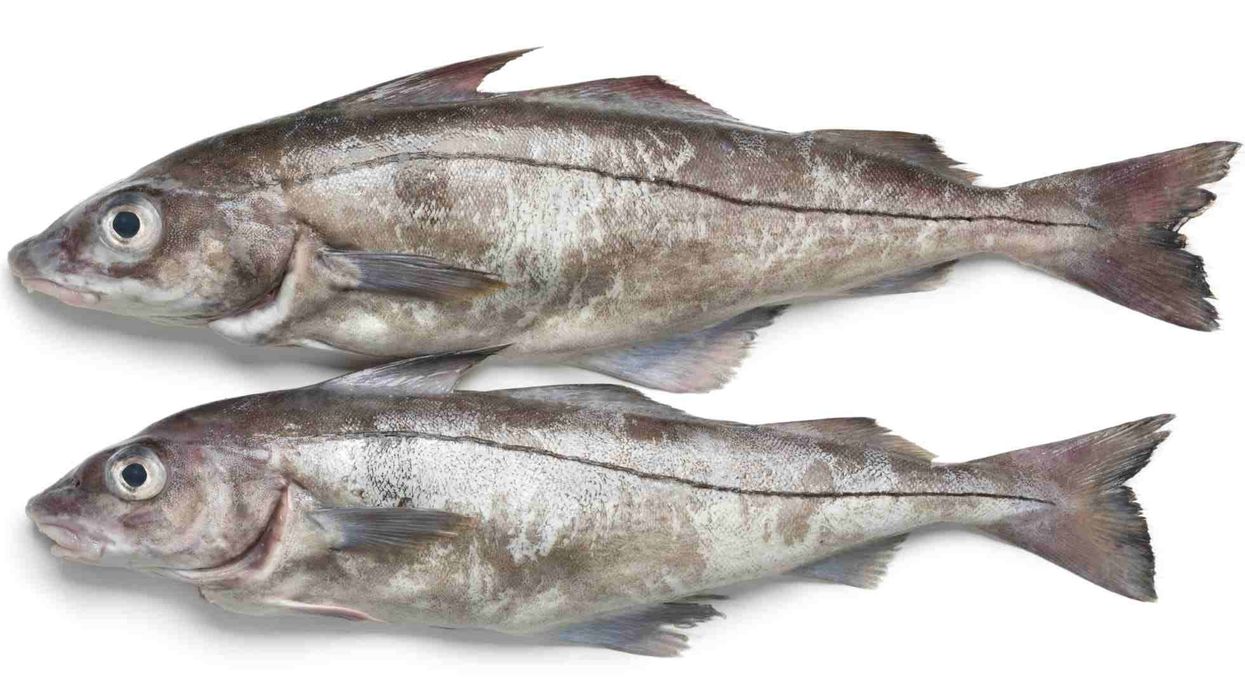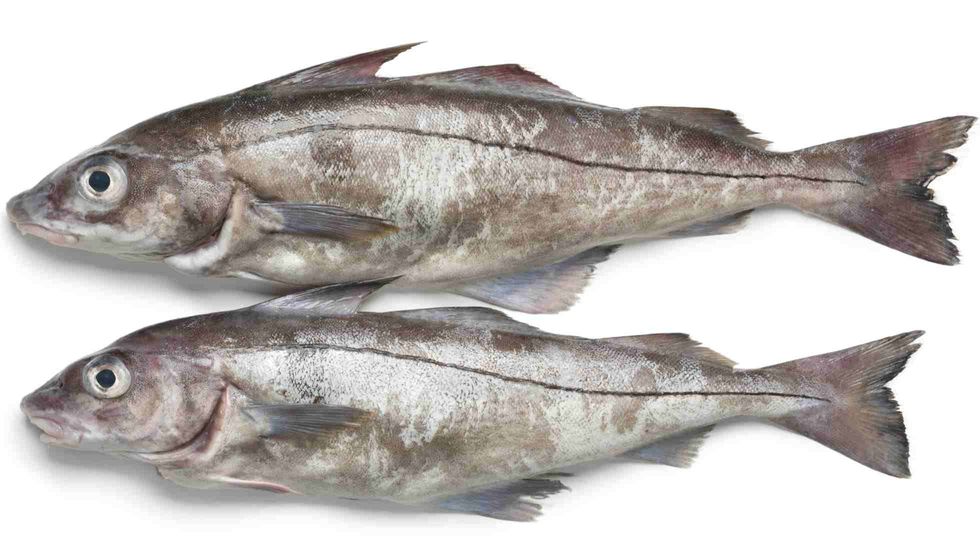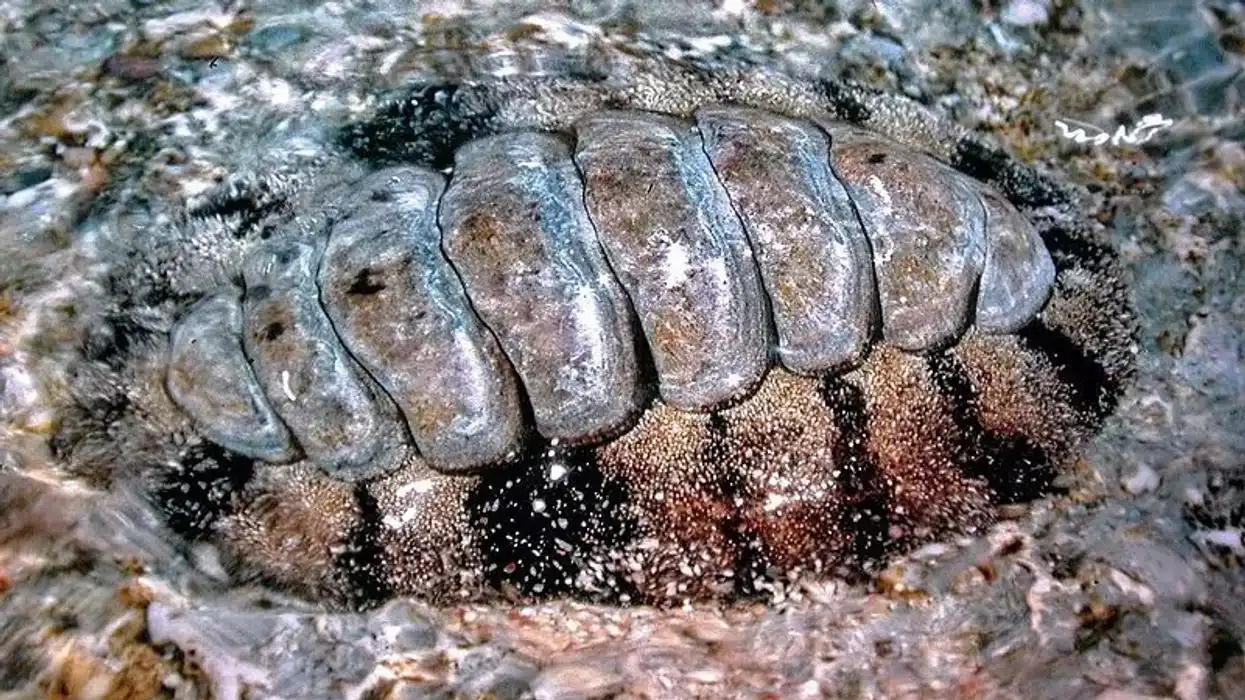Fun Haddock Facts For Kids

The haddock (Melanogrammus aeglefinus) is a marine water ray-finned fish. The haddock fish belongs to the Gadidae family, the marine fish' family.
The population is spread across the North and East Atlantic oceans and are essential fisheries species. Haddocks are saltwater demersal species or groundfish near the ocean's bottom at the depths of 133-1,500 ft (40-457 m) below the water surface.
Scientists and researchers can better understand haddock by studying this species' acoustic vocalization. Both cod and haddock are similar but can be differentiated with a darker lateral line on haddock over the dark gray body, whereas a cod is green-brown with a lighter one.
With a tall and pointed front dorsal fin, the haddock is slimmer and smaller than the bigger rounder cod.
Above the pectoral fin of this fish, the dominant dark blotch is a distinguishable haddock feature. The fish is a favorite of fish food lovers with a flavorful taste and higher nutritional value than cod.
The haddock fishing in the commercial fisheries is done year-round, and they are sold fresh or dry smoked or frozen. Read on to know more!
If you find this article interesting, you should also through skate fish and toadfish.
Haddock Interesting Facts
What type of animal is a haddock?
Haddock is a saltwater fish. The fish has an elongated tapering body related to cod but a more petite body than a codfish.
With a wedge-shaped snout and three triangular dorsal fins with multiple rays, a Haddock on its white side has a dark lateral line running across which distinguishes it from other fishes. Haddock on the pectoral fin have a dark blotch, known as a 'St. Peter's mark' or 'Devil's thumbprint'.
What class of animal does a haddock belong to?
Haddock fish belongs to the Actinopterygii class of the Animalia kingdom. The fish is related to other fishes in the Gadidae family. This family of marine fishes includes the cod, Haddock, whiting, and pollock, which are fished commercially in the fisheries. The fish is sold either fresh or dry smoked in the region.
How many haddocks are there in the world?
The haddock fish population in the North Atlantic ocean varies in thousands and is commercially an essential fish in the fisheries for many nations in this region. However, this fish is more abundant in East Atlantic areas.
As it is popularly known, the North Atlantic Haddock is an essential part of these nations' diets for its high nutrition value. Even with females producing an average of 850,000 eggs, their survival and growth rate is good but for climatic changes cause their population to decline.
Where does a haddock live?
Haddocks are endemic to the North and East Atlantic Oceans. Haddocks can be found from the Strait of Belle Isle to New England in the northwest Atlantic, and in the northeast, they can be found in the Bay of Biscay, around Scandinavia, and the Russian Arctic.
What is a haddock's habitat?
Haddocks are demersal species which means they live near the ocean beds. Haddocks are found at depths between 133-1,500 ft (40-457 m) under seawater's surface. They are migratory species preferring colder temperatures between 39-50°F (3.9-10 C).
Haddocks prefer the ocean bottom with smooth & hard clayey sand, and smooth areas between rocky patches. They are seldom found near the coast. As they age, they prefer deeper sand beds since the fish feed on various bottom-dwelling animals, including mollusks, worms, and crustaceans.
Who do haddocks live with?
Haddocks swim in large schools. These fishes' are in shallow to deep water near the ocean beds. The ocean's depth where they are found is directly proportional to their fishes' age, with juveniles preferring shallower waters and larger ones deeper water with various bottom-dwelling marine animals.
How long does a haddock live?
The lifespan of a Haddock is 7-10 years. After hatching from the eggs, this species' growth rate is very high. For the first few months, the juveniles stay near the water's surface, after which they start settling down on the sea beds from the shallow waters to deeper ones.
How do they reproduce?
Reproduction happens by way of spawning in this species. A haddock fish reaches sexual maturity between one to four years of age. Once the females lay their eggs near the sea bed, the male fertilizes them. These fertile eggs then move to the water's surface, and the hatchlings come out after three days.
They drift with the ocean currents. Juveniles stay near the water surface before settling down on the sea bed. The number of eggs laid by females increases with females' age.
What is their conservation status?
According to the IUCN Red List, haddocks are a Vulnerable species. The decline in the population is because of the over-fishing of this species.
haddocks are preyed on by spiny dogfish, skate, cod, monkfish, halibut, sea raven, and seals. The trawling method used by fishermen to fish this species destroys its habitat when the nets are dragged to scoop out the fishes along the bottom of the seabed.
Haddock Fun Facts
What do haddocks look like?
Haddocks are related cod-fishes and resemble in their elongated body structure but are slimmer compared to cod with more rounded features. They have purplish-gray-colored heads with silvery underneath. A pinkish tinge across the belly and dark lateral line along with dark blotch over its pictorial fin are its colorful features.
 " site_id=26332962 is_animated_gif="false" original_size="800x600" crop_info="%7B%22image%22%3A%20%22https%3A//assets.rbl.ms/50134072/origin.jpg%22%2C%20%22thumbnails%22%3A%20%7B%22origin%22%3A%20%22https%3A//assets.rbl.ms/50134072/origin.jpg%22%2C%20%22300x%22%3A%20%22https%3A//kidadl.rebelmouse.dev/media-library/eyJhbGciOiJIUzI1NiIsInR5cCI6IkpXVCJ9.eyJpbWFnZSI6Imh0dHBzOi8vYXNzZXRzLnJibC5tcy81MDEzNDA3Mi9vcmlnaW4uanBnIiwiZXhwaXJlc19hdCI6MTc2MDUxMzUyOX0.sy3cWAxOiUe7QnbyoXsx8UGOu1uSQrGo4utMahBMQco/image.jpg%3Fwidth%3D300%22%2C%20%221200x800%22%3A%20%22https%3A//kidadl.rebelmouse.dev/media-library/eyJhbGciOiJIUzI1NiIsInR5cCI6IkpXVCJ9.eyJpbWFnZSI6Imh0dHBzOi8vYXNzZXRzLnJibC5tcy81MDEzNDA3Mi9vcmlnaW4uanBnIiwiZXhwaXJlc19hdCI6MTc2MDUxMzUyOX0.sy3cWAxOiUe7QnbyoXsx8UGOu1uSQrGo4utMahBMQco/image.jpg%3Fwidth%3D1200%26height%3D800%26coordinates%3D0%252C33%252C0%252C34%22%2C%20%221000x750%22%3A%20%22https%3A//kidadl.rebelmouse.dev/media-library/eyJhbGciOiJIUzI1NiIsInR5cCI6IkpXVCJ9.eyJpbWFnZSI6Imh0dHBzOi8vYXNzZXRzLnJibC5tcy81MDEzNDA3Mi9vcmlnaW4uanBnIiwiZXhwaXJlc19hdCI6MTc2MDUxMzUyOX0.sy3cWAxOiUe7QnbyoXsx8UGOu1uSQrGo4utMahBMQco/image.jpg%3Fwidth%3D1000%26height%3D750%26coordinates%3D0%252C0%252C0%252C0%22%2C%20%221200x600%22%3A%20%22https%3A//kidadl.rebelmouse.dev/media-library/eyJhbGciOiJIUzI1NiIsInR5cCI6IkpXVCJ9.eyJpbWFnZSI6Imh0dHBzOi8vYXNzZXRzLnJibC5tcy81MDEzNDA3Mi9vcmlnaW4uanBnIiwiZXhwaXJlc19hdCI6MTc2MDUxMzUyOX0.sy3cWAxOiUe7QnbyoXsx8UGOu1uSQrGo4utMahBMQco/image.jpg%3Fwidth%3D1200%26height%3D600%26coordinates%3D0%252C100%252C0%252C100%22%2C%20%2235x35%22%3A%20%22https%3A//kidadl.rebelmouse.dev/media-library/eyJhbGciOiJIUzI1NiIsInR5cCI6IkpXVCJ9.eyJpbWFnZSI6Imh0dHBzOi8vYXNzZXRzLnJibC5tcy81MDEzNDA3Mi9vcmlnaW4uanBnIiwiZXhwaXJlc19hdCI6MTc2MDUxMzUyOX0.sy3cWAxOiUe7QnbyoXsx8UGOu1uSQrGo4utMahBMQco/image.jpg%3Fwidth%3D35%26height%3D35%22%2C%20%22600x%22%3A%20%22https%3A//kidadl.rebelmouse.dev/media-library/eyJhbGciOiJIUzI1NiIsInR5cCI6IkpXVCJ9.eyJpbWFnZSI6Imh0dHBzOi8vYXNzZXRzLnJibC5tcy81MDEzNDA3Mi9vcmlnaW4uanBnIiwiZXhwaXJlc19hdCI6MTc2MDUxMzUyOX0.sy3cWAxOiUe7QnbyoXsx8UGOu1uSQrGo4utMahBMQco/image.jpg%3Fwidth%3D600%22%2C%20%22600x300%22%3A%20%22https%3A//kidadl.rebelmouse.dev/media-library/eyJhbGciOiJIUzI1NiIsInR5cCI6IkpXVCJ9.eyJpbWFnZSI6Imh0dHBzOi8vYXNzZXRzLnJibC5tcy81MDEzNDA3Mi9vcmlnaW4uanBnIiwiZXhwaXJlc19hdCI6MTc2MDUxMzUyOX0.sy3cWAxOiUe7QnbyoXsx8UGOu1uSQrGo4utMahBMQco/image.jpg%3Fwidth%3D600%26height%3D300%26coordinates%3D0%252C100%252C0%252C100%22%2C%20%22600x600%22%3A%20%22https%3A//kidadl.rebelmouse.dev/media-library/eyJhbGciOiJIUzI1NiIsInR5cCI6IkpXVCJ9.eyJpbWFnZSI6Imh0dHBzOi8vYXNzZXRzLnJibC5tcy81MDEzNDA3Mi9vcmlnaW4uanBnIiwiZXhwaXJlc19hdCI6MTc2MDUxMzUyOX0.sy3cWAxOiUe7QnbyoXsx8UGOu1uSQrGo4utMahBMQco/image.jpg%3Fwidth%3D600%26height%3D600%26coordinates%3D100%252C0%252C100%252C0%22%2C%20%22980x%22%3A%20%22https%3A//kidadl.rebelmouse.dev/media-library/eyJhbGciOiJIUzI1NiIsInR5cCI6IkpXVCJ9.eyJpbWFnZSI6Imh0dHBzOi8vYXNzZXRzLnJibC5tcy81MDEzNDA3Mi9vcmlnaW4uanBnIiwiZXhwaXJlc19hdCI6MTc2MDUxMzUyOX0.sy3cWAxOiUe7QnbyoXsx8UGOu1uSQrGo4utMahBMQco/image.jpg%3Fwidth%3D980%22%2C%20%22600x400%22%3A%20%22https%3A//kidadl.rebelmouse.dev/media-library/eyJhbGciOiJIUzI1NiIsInR5cCI6IkpXVCJ9.eyJpbWFnZSI6Imh0dHBzOi8vYXNzZXRzLnJibC5tcy81MDEzNDA3Mi9vcmlnaW4uanBnIiwiZXhwaXJlc19hdCI6MTc2MDUxMzUyOX0.sy3cWAxOiUe7QnbyoXsx8UGOu1uSQrGo4utMahBMQco/image.jpg%3Fwidth%3D600%26height%3D400%26coordinates%3D0%252C33%252C0%252C34%22%2C%20%222000x1500%22%3A%20%22https%3A//kidadl.rebelmouse.dev/media-library/eyJhbGciOiJIUzI1NiIsInR5cCI6IkpXVCJ9.eyJpbWFnZSI6Imh0dHBzOi8vYXNzZXRzLnJibC5tcy81MDEzNDA3Mi9vcmlnaW4uanBnIiwiZXhwaXJlc19hdCI6MTc2MDUxMzUyOX0.sy3cWAxOiUe7QnbyoXsx8UGOu1uSQrGo4utMahBMQco/image.jpg%3Fwidth%3D2000%26height%3D1500%26coordinates%3D0%252C0%252C0%252C0%22%2C%20%22300x300%22%3A%20%22https%3A//kidadl.rebelmouse.dev/media-library/eyJhbGciOiJIUzI1NiIsInR5cCI6IkpXVCJ9.eyJpbWFnZSI6Imh0dHBzOi8vYXNzZXRzLnJibC5tcy81MDEzNDA3Mi9vcmlnaW4uanBnIiwiZXhwaXJlc19hdCI6MTc2MDUxMzUyOX0.sy3cWAxOiUe7QnbyoXsx8UGOu1uSQrGo4utMahBMQco/image.jpg%3Fwidth%3D300%26height%3D300%26coordinates%3D100%252C0%252C100%252C0%22%2C%20%221200x400%22%3A%20%22https%3A//kidadl.rebelmouse.dev/media-library/eyJhbGciOiJIUzI1NiIsInR5cCI6IkpXVCJ9.eyJpbWFnZSI6Imh0dHBzOi8vYXNzZXRzLnJibC5tcy81MDEzNDA3Mi9vcmlnaW4uanBnIiwiZXhwaXJlc19hdCI6MTc2MDUxMzUyOX0.sy3cWAxOiUe7QnbyoXsx8UGOu1uSQrGo4utMahBMQco/image.jpg%3Fwidth%3D1200%26height%3D400%26coordinates%3D0%252C167%252C0%252C167%22%2C%20%221500x2000%22%3A%20%22https%3A//kidadl.rebelmouse.dev/media-library/eyJhbGciOiJIUzI1NiIsInR5cCI6IkpXVCJ9.eyJpbWFnZSI6Imh0dHBzOi8vYXNzZXRzLnJibC5tcy81MDEzNDA3Mi9vcmlnaW4uanBnIiwiZXhwaXJlc19hdCI6MTc2MDUxMzUyOX0.sy3cWAxOiUe7QnbyoXsx8UGOu1uSQrGo4utMahBMQco/image.jpg%3Fwidth%3D1500%26height%3D2000%26coordinates%3D175%252C0%252C175%252C0%22%2C%20%22700x1245%22%3A%20%22https%3A//kidadl.rebelmouse.dev/media-library/eyJhbGciOiJIUzI1NiIsInR5cCI6IkpXVCJ9.eyJpbWFnZSI6Imh0dHBzOi8vYXNzZXRzLnJibC5tcy81MDEzNDA3Mi9vcmlnaW4uanBnIiwiZXhwaXJlc19hdCI6MTc2MDUxMzUyOX0.sy3cWAxOiUe7QnbyoXsx8UGOu1uSQrGo4utMahBMQco/image.jpg%3Fwidth%3D700%26height%3D1245%26coordinates%3D231%252C0%252C231%252C0%22%2C%20%22750x1000%22%3A%20%22https%3A//kidadl.rebelmouse.dev/media-library/eyJhbGciOiJIUzI1NiIsInR5cCI6IkpXVCJ9.eyJpbWFnZSI6Imh0dHBzOi8vYXNzZXRzLnJibC5tcy81MDEzNDA3Mi9vcmlnaW4uanBnIiwiZXhwaXJlc19hdCI6MTc2MDUxMzUyOX0.sy3cWAxOiUe7QnbyoXsx8UGOu1uSQrGo4utMahBMQco/image.jpg%3Fwidth%3D750%26height%3D1000%26coordinates%3D175%252C0%252C175%252C0%22%2C%20%22600x200%22%3A%20%22https%3A//kidadl.rebelmouse.dev/media-library/eyJhbGciOiJIUzI1NiIsInR5cCI6IkpXVCJ9.eyJpbWFnZSI6Imh0dHBzOi8vYXNzZXRzLnJibC5tcy81MDEzNDA3Mi9vcmlnaW4uanBnIiwiZXhwaXJlc19hdCI6MTc2MDUxMzUyOX0.sy3cWAxOiUe7QnbyoXsx8UGOu1uSQrGo4utMahBMQco/image.jpg%3Fwidth%3D600%26height%3D200%26coordinates%3D0%252C167%252C0%252C167%22%2C%20%22210x%22%3A%20%22https%3A//kidadl.rebelmouse.dev/media-library/eyJhbGciOiJIUzI1NiIsInR5cCI6IkpXVCJ9.eyJpbWFnZSI6Imh0dHBzOi8vYXNzZXRzLnJibC5tcy81MDEzNDA3Mi9vcmlnaW4uanBnIiwiZXhwaXJlc19hdCI6MTc2MDUxMzUyOX0.sy3cWAxOiUe7QnbyoXsx8UGOu1uSQrGo4utMahBMQco/image.jpg%3Fwidth%3D210%22%2C%20%221245x700%22%3A%20%22https%3A//kidadl.rebelmouse.dev/media-library/eyJhbGciOiJIUzI1NiIsInR5cCI6IkpXVCJ9.eyJpbWFnZSI6Imh0dHBzOi8vYXNzZXRzLnJibC5tcy81MDEzNDA3Mi9vcmlnaW4uanBnIiwiZXhwaXJlc19hdCI6MTc2MDUxMzUyOX0.sy3cWAxOiUe7QnbyoXsx8UGOu1uSQrGo4utMahBMQco/image.jpg%3Fwidth%3D1245%26height%3D700%26coordinates%3D0%252C75%252C0%252C75%22%7D%2C%20%22manual_image_crops%22%3A%20%7B%229x16%22%3A%20%7B%22sizes%22%3A%20%5B%22700x1245%22%5D%2C%20%22top%22%3A%200%2C%20%22height%22%3A%20600%2C%20%22width%22%3A%20338%2C%20%22left%22%3A%20231%7D%2C%20%22600x300%22%3A%20%7B%22sizes%22%3A%20%5B%22600x300%22%5D%2C%20%22top%22%3A%20100%2C%20%22height%22%3A%20400%2C%20%22width%22%3A%20800%2C%20%22left%22%3A%200%7D%2C%20%223x1%22%3A%20%7B%22sizes%22%3A%20%5B%221200x400%22%2C%20%22600x200%22%5D%2C%20%22top%22%3A%20167%2C%20%22height%22%3A%20266%2C%20%22width%22%3A%20800%2C%20%22left%22%3A%200%7D%2C%20%223x2%22%3A%20%7B%22sizes%22%3A%20%5B%221200x800%22%2C%20%22600x400%22%5D%2C%20%22top%22%3A%2033%2C%20%22height%22%3A%20533%2C%20%22width%22%3A%20800%2C%20%22left%22%3A%200%7D%2C%20%221x1%22%3A%20%7B%22sizes%22%3A%20%5B%22600x600%22%2C%20%22300x300%22%5D%2C%20%22top%22%3A%200%2C%20%22height%22%3A%20600%2C%20%22width%22%3A%20600%2C%20%22left%22%3A%20100%7D%2C%20%223x4%22%3A%20%7B%22sizes%22%3A%20%5B%221500x2000%22%2C%20%22750x1000%22%5D%2C%20%22top%22%3A%200%2C%20%22height%22%3A%20600%2C%20%22width%22%3A%20450%2C%20%22left%22%3A%20175%7D%2C%20%2216x9%22%3A%20%7B%22sizes%22%3A%20%5B%221245x700%22%5D%2C%20%22top%22%3A%2075%2C%20%22height%22%3A%20450%2C%20%22width%22%3A%20800%2C%20%22left%22%3A%200%7D%2C%20%224x3%22%3A%20%7B%22sizes%22%3A%20%5B%222000x1500%22%2C%20%221000x750%22%5D%2C%20%22top%22%3A%200%2C%20%22height%22%3A%20600%2C%20%22width%22%3A%20800%2C%20%22left%22%3A%200%7D%2C%20%222x1%22%3A%20%7B%22sizes%22%3A%20%5B%221200x600%22%2C%20%22600x300%22%5D%2C%20%22top%22%3A%20100%2C%20%22height%22%3A%20400%2C%20%22width%22%3A%20800%2C%20%22left%22%3A%200%7D%7D%7D" caption="" photo_credit="" title="Haddock-2.jpg"]
" site_id=26332962 is_animated_gif="false" original_size="800x600" crop_info="%7B%22image%22%3A%20%22https%3A//assets.rbl.ms/50134072/origin.jpg%22%2C%20%22thumbnails%22%3A%20%7B%22origin%22%3A%20%22https%3A//assets.rbl.ms/50134072/origin.jpg%22%2C%20%22300x%22%3A%20%22https%3A//kidadl.rebelmouse.dev/media-library/eyJhbGciOiJIUzI1NiIsInR5cCI6IkpXVCJ9.eyJpbWFnZSI6Imh0dHBzOi8vYXNzZXRzLnJibC5tcy81MDEzNDA3Mi9vcmlnaW4uanBnIiwiZXhwaXJlc19hdCI6MTc2MDUxMzUyOX0.sy3cWAxOiUe7QnbyoXsx8UGOu1uSQrGo4utMahBMQco/image.jpg%3Fwidth%3D300%22%2C%20%221200x800%22%3A%20%22https%3A//kidadl.rebelmouse.dev/media-library/eyJhbGciOiJIUzI1NiIsInR5cCI6IkpXVCJ9.eyJpbWFnZSI6Imh0dHBzOi8vYXNzZXRzLnJibC5tcy81MDEzNDA3Mi9vcmlnaW4uanBnIiwiZXhwaXJlc19hdCI6MTc2MDUxMzUyOX0.sy3cWAxOiUe7QnbyoXsx8UGOu1uSQrGo4utMahBMQco/image.jpg%3Fwidth%3D1200%26height%3D800%26coordinates%3D0%252C33%252C0%252C34%22%2C%20%221000x750%22%3A%20%22https%3A//kidadl.rebelmouse.dev/media-library/eyJhbGciOiJIUzI1NiIsInR5cCI6IkpXVCJ9.eyJpbWFnZSI6Imh0dHBzOi8vYXNzZXRzLnJibC5tcy81MDEzNDA3Mi9vcmlnaW4uanBnIiwiZXhwaXJlc19hdCI6MTc2MDUxMzUyOX0.sy3cWAxOiUe7QnbyoXsx8UGOu1uSQrGo4utMahBMQco/image.jpg%3Fwidth%3D1000%26height%3D750%26coordinates%3D0%252C0%252C0%252C0%22%2C%20%221200x600%22%3A%20%22https%3A//kidadl.rebelmouse.dev/media-library/eyJhbGciOiJIUzI1NiIsInR5cCI6IkpXVCJ9.eyJpbWFnZSI6Imh0dHBzOi8vYXNzZXRzLnJibC5tcy81MDEzNDA3Mi9vcmlnaW4uanBnIiwiZXhwaXJlc19hdCI6MTc2MDUxMzUyOX0.sy3cWAxOiUe7QnbyoXsx8UGOu1uSQrGo4utMahBMQco/image.jpg%3Fwidth%3D1200%26height%3D600%26coordinates%3D0%252C100%252C0%252C100%22%2C%20%2235x35%22%3A%20%22https%3A//kidadl.rebelmouse.dev/media-library/eyJhbGciOiJIUzI1NiIsInR5cCI6IkpXVCJ9.eyJpbWFnZSI6Imh0dHBzOi8vYXNzZXRzLnJibC5tcy81MDEzNDA3Mi9vcmlnaW4uanBnIiwiZXhwaXJlc19hdCI6MTc2MDUxMzUyOX0.sy3cWAxOiUe7QnbyoXsx8UGOu1uSQrGo4utMahBMQco/image.jpg%3Fwidth%3D35%26height%3D35%22%2C%20%22600x%22%3A%20%22https%3A//kidadl.rebelmouse.dev/media-library/eyJhbGciOiJIUzI1NiIsInR5cCI6IkpXVCJ9.eyJpbWFnZSI6Imh0dHBzOi8vYXNzZXRzLnJibC5tcy81MDEzNDA3Mi9vcmlnaW4uanBnIiwiZXhwaXJlc19hdCI6MTc2MDUxMzUyOX0.sy3cWAxOiUe7QnbyoXsx8UGOu1uSQrGo4utMahBMQco/image.jpg%3Fwidth%3D600%22%2C%20%22600x300%22%3A%20%22https%3A//kidadl.rebelmouse.dev/media-library/eyJhbGciOiJIUzI1NiIsInR5cCI6IkpXVCJ9.eyJpbWFnZSI6Imh0dHBzOi8vYXNzZXRzLnJibC5tcy81MDEzNDA3Mi9vcmlnaW4uanBnIiwiZXhwaXJlc19hdCI6MTc2MDUxMzUyOX0.sy3cWAxOiUe7QnbyoXsx8UGOu1uSQrGo4utMahBMQco/image.jpg%3Fwidth%3D600%26height%3D300%26coordinates%3D0%252C100%252C0%252C100%22%2C%20%22600x600%22%3A%20%22https%3A//kidadl.rebelmouse.dev/media-library/eyJhbGciOiJIUzI1NiIsInR5cCI6IkpXVCJ9.eyJpbWFnZSI6Imh0dHBzOi8vYXNzZXRzLnJibC5tcy81MDEzNDA3Mi9vcmlnaW4uanBnIiwiZXhwaXJlc19hdCI6MTc2MDUxMzUyOX0.sy3cWAxOiUe7QnbyoXsx8UGOu1uSQrGo4utMahBMQco/image.jpg%3Fwidth%3D600%26height%3D600%26coordinates%3D100%252C0%252C100%252C0%22%2C%20%22980x%22%3A%20%22https%3A//kidadl.rebelmouse.dev/media-library/eyJhbGciOiJIUzI1NiIsInR5cCI6IkpXVCJ9.eyJpbWFnZSI6Imh0dHBzOi8vYXNzZXRzLnJibC5tcy81MDEzNDA3Mi9vcmlnaW4uanBnIiwiZXhwaXJlc19hdCI6MTc2MDUxMzUyOX0.sy3cWAxOiUe7QnbyoXsx8UGOu1uSQrGo4utMahBMQco/image.jpg%3Fwidth%3D980%22%2C%20%22600x400%22%3A%20%22https%3A//kidadl.rebelmouse.dev/media-library/eyJhbGciOiJIUzI1NiIsInR5cCI6IkpXVCJ9.eyJpbWFnZSI6Imh0dHBzOi8vYXNzZXRzLnJibC5tcy81MDEzNDA3Mi9vcmlnaW4uanBnIiwiZXhwaXJlc19hdCI6MTc2MDUxMzUyOX0.sy3cWAxOiUe7QnbyoXsx8UGOu1uSQrGo4utMahBMQco/image.jpg%3Fwidth%3D600%26height%3D400%26coordinates%3D0%252C33%252C0%252C34%22%2C%20%222000x1500%22%3A%20%22https%3A//kidadl.rebelmouse.dev/media-library/eyJhbGciOiJIUzI1NiIsInR5cCI6IkpXVCJ9.eyJpbWFnZSI6Imh0dHBzOi8vYXNzZXRzLnJibC5tcy81MDEzNDA3Mi9vcmlnaW4uanBnIiwiZXhwaXJlc19hdCI6MTc2MDUxMzUyOX0.sy3cWAxOiUe7QnbyoXsx8UGOu1uSQrGo4utMahBMQco/image.jpg%3Fwidth%3D2000%26height%3D1500%26coordinates%3D0%252C0%252C0%252C0%22%2C%20%22300x300%22%3A%20%22https%3A//kidadl.rebelmouse.dev/media-library/eyJhbGciOiJIUzI1NiIsInR5cCI6IkpXVCJ9.eyJpbWFnZSI6Imh0dHBzOi8vYXNzZXRzLnJibC5tcy81MDEzNDA3Mi9vcmlnaW4uanBnIiwiZXhwaXJlc19hdCI6MTc2MDUxMzUyOX0.sy3cWAxOiUe7QnbyoXsx8UGOu1uSQrGo4utMahBMQco/image.jpg%3Fwidth%3D300%26height%3D300%26coordinates%3D100%252C0%252C100%252C0%22%2C%20%221200x400%22%3A%20%22https%3A//kidadl.rebelmouse.dev/media-library/eyJhbGciOiJIUzI1NiIsInR5cCI6IkpXVCJ9.eyJpbWFnZSI6Imh0dHBzOi8vYXNzZXRzLnJibC5tcy81MDEzNDA3Mi9vcmlnaW4uanBnIiwiZXhwaXJlc19hdCI6MTc2MDUxMzUyOX0.sy3cWAxOiUe7QnbyoXsx8UGOu1uSQrGo4utMahBMQco/image.jpg%3Fwidth%3D1200%26height%3D400%26coordinates%3D0%252C167%252C0%252C167%22%2C%20%221500x2000%22%3A%20%22https%3A//kidadl.rebelmouse.dev/media-library/eyJhbGciOiJIUzI1NiIsInR5cCI6IkpXVCJ9.eyJpbWFnZSI6Imh0dHBzOi8vYXNzZXRzLnJibC5tcy81MDEzNDA3Mi9vcmlnaW4uanBnIiwiZXhwaXJlc19hdCI6MTc2MDUxMzUyOX0.sy3cWAxOiUe7QnbyoXsx8UGOu1uSQrGo4utMahBMQco/image.jpg%3Fwidth%3D1500%26height%3D2000%26coordinates%3D175%252C0%252C175%252C0%22%2C%20%22700x1245%22%3A%20%22https%3A//kidadl.rebelmouse.dev/media-library/eyJhbGciOiJIUzI1NiIsInR5cCI6IkpXVCJ9.eyJpbWFnZSI6Imh0dHBzOi8vYXNzZXRzLnJibC5tcy81MDEzNDA3Mi9vcmlnaW4uanBnIiwiZXhwaXJlc19hdCI6MTc2MDUxMzUyOX0.sy3cWAxOiUe7QnbyoXsx8UGOu1uSQrGo4utMahBMQco/image.jpg%3Fwidth%3D700%26height%3D1245%26coordinates%3D231%252C0%252C231%252C0%22%2C%20%22750x1000%22%3A%20%22https%3A//kidadl.rebelmouse.dev/media-library/eyJhbGciOiJIUzI1NiIsInR5cCI6IkpXVCJ9.eyJpbWFnZSI6Imh0dHBzOi8vYXNzZXRzLnJibC5tcy81MDEzNDA3Mi9vcmlnaW4uanBnIiwiZXhwaXJlc19hdCI6MTc2MDUxMzUyOX0.sy3cWAxOiUe7QnbyoXsx8UGOu1uSQrGo4utMahBMQco/image.jpg%3Fwidth%3D750%26height%3D1000%26coordinates%3D175%252C0%252C175%252C0%22%2C%20%22600x200%22%3A%20%22https%3A//kidadl.rebelmouse.dev/media-library/eyJhbGciOiJIUzI1NiIsInR5cCI6IkpXVCJ9.eyJpbWFnZSI6Imh0dHBzOi8vYXNzZXRzLnJibC5tcy81MDEzNDA3Mi9vcmlnaW4uanBnIiwiZXhwaXJlc19hdCI6MTc2MDUxMzUyOX0.sy3cWAxOiUe7QnbyoXsx8UGOu1uSQrGo4utMahBMQco/image.jpg%3Fwidth%3D600%26height%3D200%26coordinates%3D0%252C167%252C0%252C167%22%2C%20%22210x%22%3A%20%22https%3A//kidadl.rebelmouse.dev/media-library/eyJhbGciOiJIUzI1NiIsInR5cCI6IkpXVCJ9.eyJpbWFnZSI6Imh0dHBzOi8vYXNzZXRzLnJibC5tcy81MDEzNDA3Mi9vcmlnaW4uanBnIiwiZXhwaXJlc19hdCI6MTc2MDUxMzUyOX0.sy3cWAxOiUe7QnbyoXsx8UGOu1uSQrGo4utMahBMQco/image.jpg%3Fwidth%3D210%22%2C%20%221245x700%22%3A%20%22https%3A//kidadl.rebelmouse.dev/media-library/eyJhbGciOiJIUzI1NiIsInR5cCI6IkpXVCJ9.eyJpbWFnZSI6Imh0dHBzOi8vYXNzZXRzLnJibC5tcy81MDEzNDA3Mi9vcmlnaW4uanBnIiwiZXhwaXJlc19hdCI6MTc2MDUxMzUyOX0.sy3cWAxOiUe7QnbyoXsx8UGOu1uSQrGo4utMahBMQco/image.jpg%3Fwidth%3D1245%26height%3D700%26coordinates%3D0%252C75%252C0%252C75%22%7D%2C%20%22manual_image_crops%22%3A%20%7B%229x16%22%3A%20%7B%22sizes%22%3A%20%5B%22700x1245%22%5D%2C%20%22top%22%3A%200%2C%20%22height%22%3A%20600%2C%20%22width%22%3A%20338%2C%20%22left%22%3A%20231%7D%2C%20%22600x300%22%3A%20%7B%22sizes%22%3A%20%5B%22600x300%22%5D%2C%20%22top%22%3A%20100%2C%20%22height%22%3A%20400%2C%20%22width%22%3A%20800%2C%20%22left%22%3A%200%7D%2C%20%223x1%22%3A%20%7B%22sizes%22%3A%20%5B%221200x400%22%2C%20%22600x200%22%5D%2C%20%22top%22%3A%20167%2C%20%22height%22%3A%20266%2C%20%22width%22%3A%20800%2C%20%22left%22%3A%200%7D%2C%20%223x2%22%3A%20%7B%22sizes%22%3A%20%5B%221200x800%22%2C%20%22600x400%22%5D%2C%20%22top%22%3A%2033%2C%20%22height%22%3A%20533%2C%20%22width%22%3A%20800%2C%20%22left%22%3A%200%7D%2C%20%221x1%22%3A%20%7B%22sizes%22%3A%20%5B%22600x600%22%2C%20%22300x300%22%5D%2C%20%22top%22%3A%200%2C%20%22height%22%3A%20600%2C%20%22width%22%3A%20600%2C%20%22left%22%3A%20100%7D%2C%20%223x4%22%3A%20%7B%22sizes%22%3A%20%5B%221500x2000%22%2C%20%22750x1000%22%5D%2C%20%22top%22%3A%200%2C%20%22height%22%3A%20600%2C%20%22width%22%3A%20450%2C%20%22left%22%3A%20175%7D%2C%20%2216x9%22%3A%20%7B%22sizes%22%3A%20%5B%221245x700%22%5D%2C%20%22top%22%3A%2075%2C%20%22height%22%3A%20450%2C%20%22width%22%3A%20800%2C%20%22left%22%3A%200%7D%2C%20%224x3%22%3A%20%7B%22sizes%22%3A%20%5B%222000x1500%22%2C%20%221000x750%22%5D%2C%20%22top%22%3A%200%2C%20%22height%22%3A%20600%2C%20%22width%22%3A%20800%2C%20%22left%22%3A%200%7D%2C%20%222x1%22%3A%20%7B%22sizes%22%3A%20%5B%221200x600%22%2C%20%22600x300%22%5D%2C%20%22top%22%3A%20100%2C%20%22height%22%3A%20400%2C%20%22width%22%3A%20800%2C%20%22left%22%3A%200%7D%7D%7D" caption="" photo_credit="" title="Haddock-2.jpg"]
How cute are they?
The haddock fishes are very cute and are a lovely sight to watch underwater when they swim around in large schools. The fish is colorful with rayed fins.
How do they communicate?
Haddock makes a different vocalizing sound, and it is called knocks or hums. The haddock fish produces sounds by contracting its drumming muscles. The knocks produced by the males during the spawning season are incredibly vocal. The knocks produced by males and females are also different. The sounds are being studied to understand this fish and its behavior.
How big is a haddock?
Haddocks grow to a length of 14-23 in(35.6-58.4 cm).. With thinner fillets, the haddock is smaller than a cod-fish. They are a great fishery species with an excellent growth rate. These fishes slightly vary in their size with the waters they are found in.
How fast can a haddock swim?
Haddocks swim in groups and are observed swimming at speeds of 0.7-2 mph (1.1-3.2 kph). But when threatened, these can make a swift escape faster but for a very short time period over a small distance. For this reason, they are called sprinters.
How much does a haddock weigh?
A haddock fish weighs between 2-7 lb (0.9-3.2 kg).. At birth, a hatchling weighs just a few ounces, and the weight also varies between the male and female.
What are their male and female names of the species?
There is no specific term given to the haddock fish's different genders. They are just called male haddock and female haddock.
What would you call a baby haddock?
Small haddocks are called scrods. The larvae float with the sea currents and spread across the sea from the spawning areas in the first few months. Smaller haddock live in the shallow waters near the coast for the first few months of their lives until they become larger enough to survive in deeper waters.
What do they eat?
Haddocks in the larvae stage feed on copepods and later prey on larvaceans, small fish, copepods, decapod larvae, and krill. Fully grown haddock prey on American eels, European sprat, sand eels, gobies, Argentines, silver hake, and capelin.
Are they eaten by humans?
Yes, haddocks are very much preferred by humans as a part of their diet for the good nutritional value of this species. The fish is an excellent source of protein, vitamins, and minerals essential for good health, including selenium which helps prevent cancer, heart disease,and diabetes and boosts a weak immune system.
Haddocks are costlier than cod-fish. Finnan haddie is a cold-smoked haddock famous in Scotland and Canada.
Would they make a good pet?
Haddock fish was never domesticated and kept as a pet. Since haddocks are big, saline water species and prefer living in groups at colder temperatures, they have not been kept as pets. Their availability in abundance in the seawater is found in commercial fisheries.
Did you know...
There is a story behind the Haddock's black blotch. As the legend goes, the Devil wanted to replicate Jesus by feeding the masses with five loaves of bread and two fish.
So the Devil thrust his hand into the Atlantic Ocean to grab the haddock. But the fish escaped with an injury. The black blotch on the haddock is said to be the Devil's thumbprint from the injury, and hence its name, 'Devil's Thumbprint'.
How to cook haddock
Haddock fish is sold either fresh, smoked, frozen, or dried. Fresh haddock has a fine white flesh, firm texture, and mild flavor. Haddock is cooked in various cooking styles such as baking, sautéing, poaching, and grilled. There are many recipes available online for serving suggestions.
It is easy to cook haddock. Haddocks are costlier than cod-fish. Finnan haddie is cold-smoked haddock fish cooked in the regional method by smoking green wood and peat in northeast Scotland.
How can haddocks be recognized?
Haddocks have a very distinguishing feature, a black blotch (also known as Devil's thumbprint) above the pectoral fin. The haddock fish has a white, lean, and flaky flesh with a tender, mild, and sweet taste.
Here at Kidadl, we have carefully created lots of interesting family-friendly animal facts for everyone to discover! Learn more about some other fish including Pacific salmon, or sockeye salmon.
You can even occupy yourself at home by drawing one on our Haddock coloring pages.
We Want Your Photos!
More for You
Sources
https://www.researchgate.net/publication/237177306_Fecundity_of_Grand_Bank_Haddock
http://www.youaskandy.com/questions-answers/34-article-series-1980/4452-how-many-eggs-does-a-haddock-lay.html
https://en.wikipedia.org/wiki/Haddock
https://www.iucnredlist.org/search?query=Haddocks&searchType=species
See All
Doctorate specializing in Veterinary Medicine

Oluniyi AkandeDoctorate specializing in Veterinary Medicine
With an accomplished background as a Veterinarian, SEO content writer, and public speaker, Oluniyi brings a wealth of skills and experience to his work. Holding a Doctor of Veterinary Medicine degree from the University of Ibadan, he provides exceptional consulting services to pet owners, animal farms, and agricultural establishments. Oluniyi's impressive writing career spans over five years, during which he has produced over 5000 high-quality short- and long-form pieces of content. His versatility shines through as he tackles a diverse array of topics, including pets, real estate, sports, games, technology, landscaping, healthcare, cosmetics, personal loans, debt management, construction, and agriculture.
Bachelor of Technology specializing in Computer Science Engineering

Shray SharmaBachelor of Technology specializing in Computer Science Engineering
As an aspiring web and app developer, Shray has a passion for working with promising startups. He is currently pursuing a Bachelor's degree in Computer Science from Maharaja Surajmal Institute Of Technology while gaining experience in digital marketing. Shray has already earned a Google Analytics Certification and is well-equipped to handle analytics and data management tasks. He has also served as a marketing manager at Parallax Virtual Arts, where he oversaw the company's social media, content, and SEO strategies. Shray's goal is to create engaging content that resonates with audiences and offers valuable insights.
Disclaimer
1) Kidadl is independent and to make our service free to you the reader we are supported by advertising. We hope you love our recommendations for products and services! What we suggest is selected independently by the Kidadl team. If you purchase using the Buy Now button we may earn a small commission. This does not influence our choices. Prices are correct and items are available at the time the article was published but we cannot guarantee that on the time of reading. Please note that Kidadl is a participant in the Amazon Services LLC Associates Program, an affiliate advertising program designed to provide a means for sites to earn advertising fees by advertising and linking to Amazon. We also link to other websites, but are not responsible for their content.
2) At Kidadl, we strive to recommend the very best activities and events. We will always aim to give you accurate information at the date of publication - however, information does change, so it’s important you do your own research, double-check and make the decision that is right for your family. We recognise that not all activities and ideas are appropriate for all children and families or in all circumstances. Our recommended activities are based on age but these are a guide. We recommend that these ideas are used as inspiration, that ideas are undertaken with appropriate adult supervision, and that each adult uses their own discretion and knowledge of their children to consider the safety and suitability. Kidadl cannot accept liability for the execution of these ideas, and parental supervision is advised at all times, as safety is paramount. Anyone using the information provided by Kidadl does so at their own risk and we can not accept liability if things go wrong.
3) Because we are an educational resource, we have quotes and facts about a range of historical and modern figures. We do not endorse the actions of or rhetoric of all the people included in these collections, but we think they are important for growing minds to learn about under the guidance of parents or guardians.







